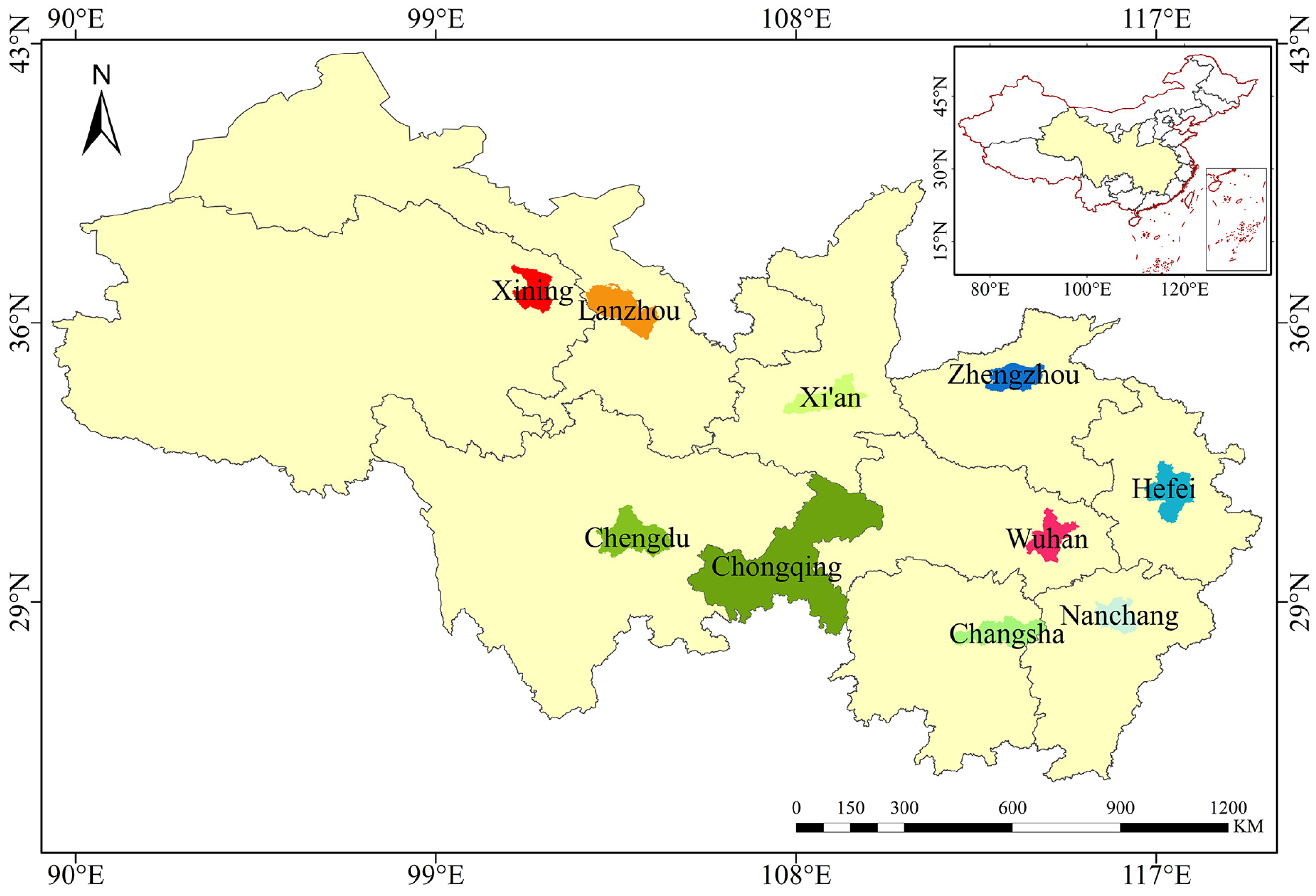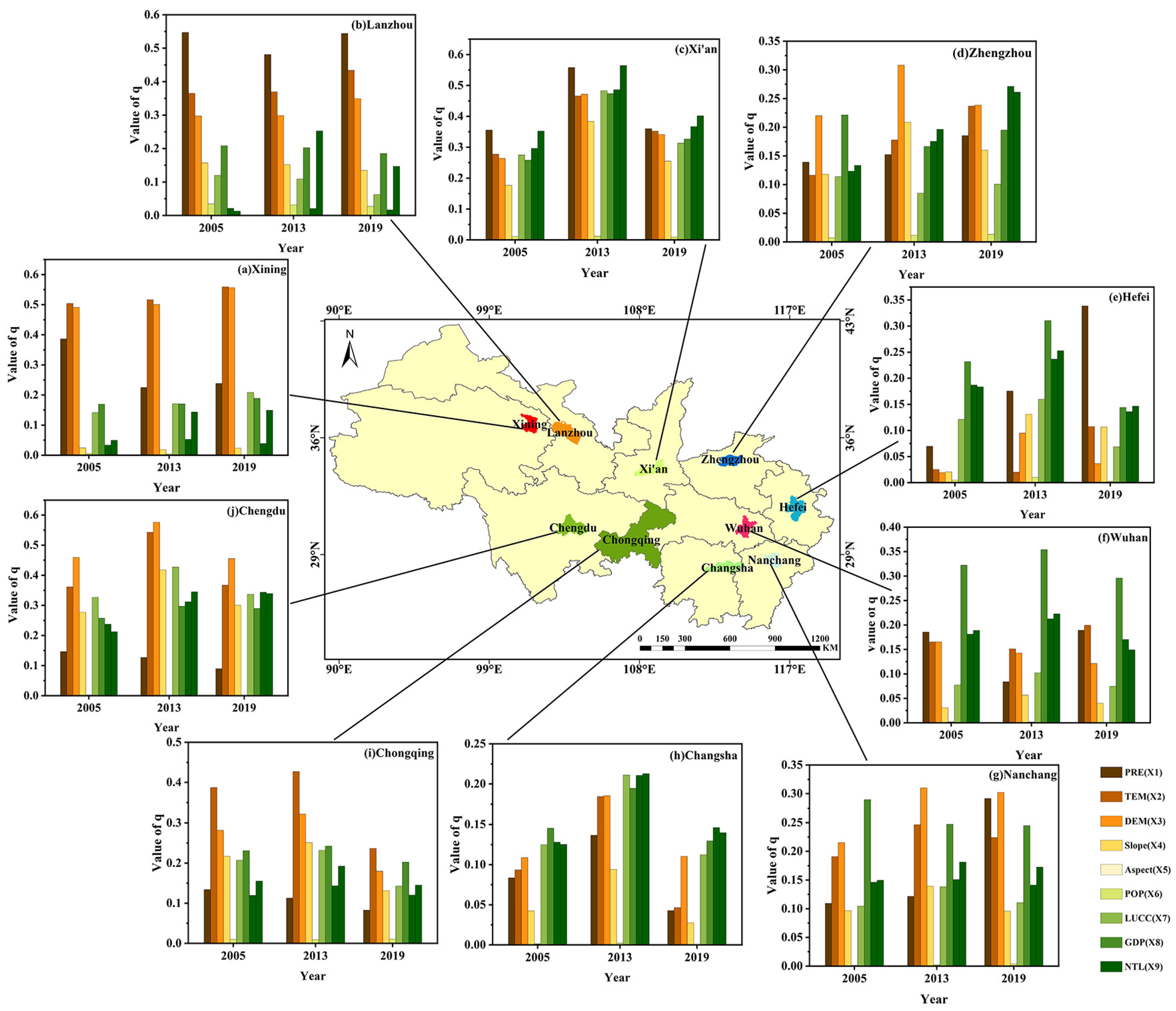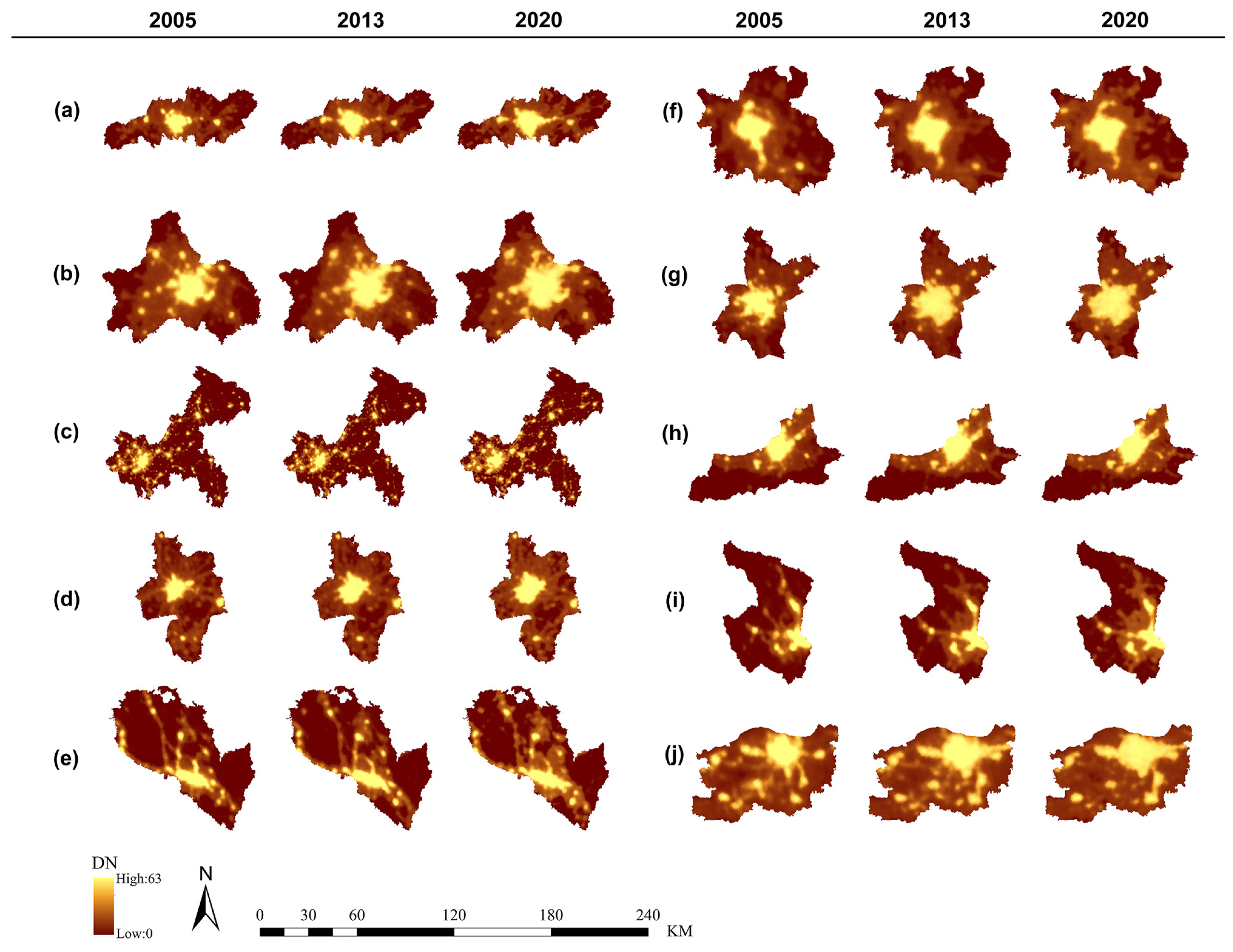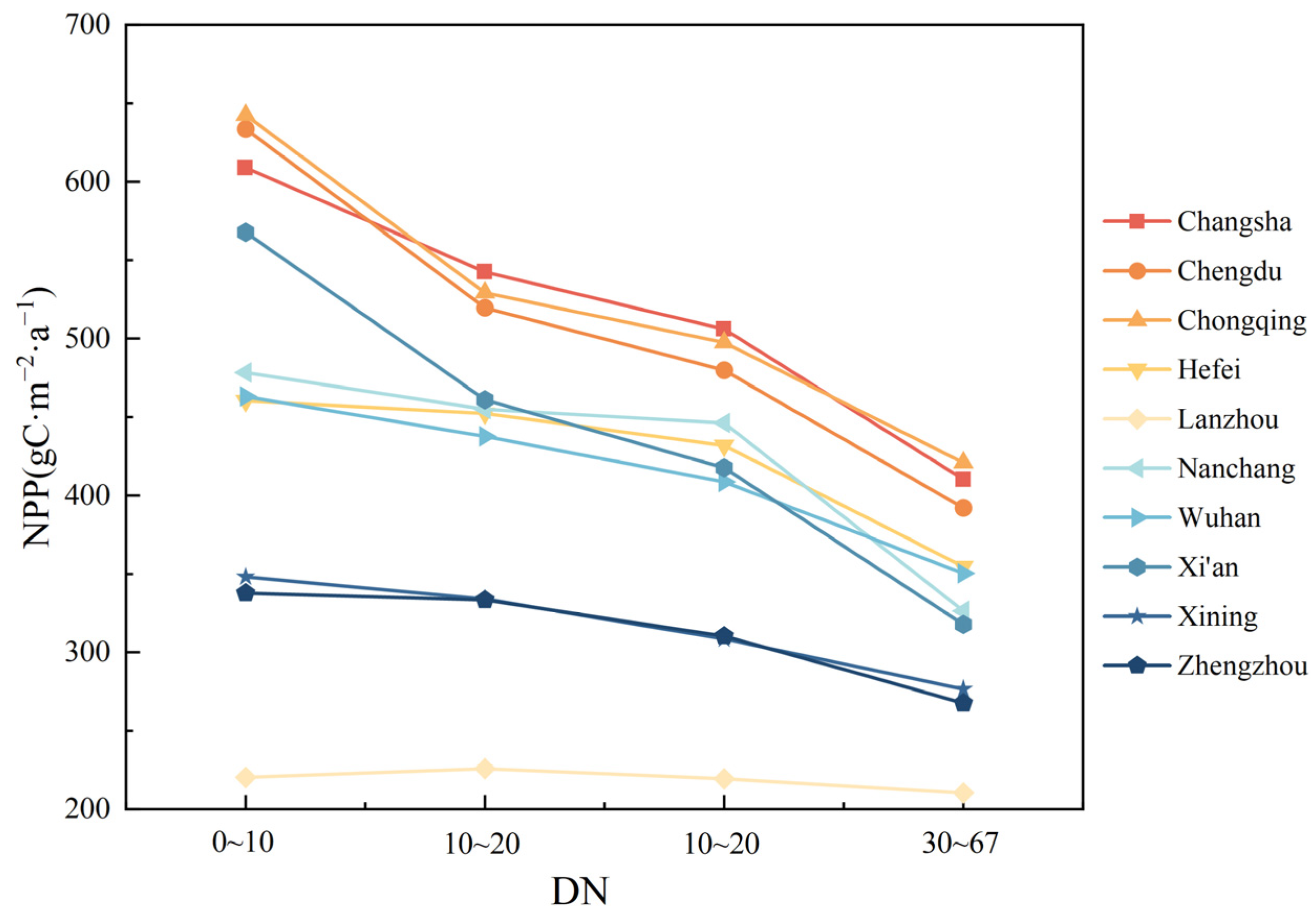Exploring the Effects of Urban Development in Ten Chinese Node Cities along the Belt and Road Initiative on Vegetation Net Primary Productivity
Abstract
:1. Introduction
2. Materials and Methods
2.1. Research Space
2.2. Data Acquisition
2.3. Methods
2.3.1. Theil-Sen Median Trend Analysis
2.3.2. Mann–Kendall Method
2.3.3. Variation Stability Analysis
2.3.4. Geographical Detector
2.3.5. Land Use Transfer Matrix
3. Results
3.1. The Inter-Annual Variations of Vegetation NPP in Each Node City
3.2. Temporal–Spatial Variations in Vegetation NPP in Each Node City
3.3. Examining the Effects of Several Influential Factors on NPP
3.3.1. Identification of Crucial Variables
3.3.2. Changes in Land Use Affect Vegetation NPP
3.3.3. NTL Spatial Pattern and Its Relationship with NPP
3.3.4. Interaction Analysis between Factors
4. Discussion
4.1. NPP Temporal and Spatial Changes
4.2. Variation in the NPP Caused by Driving Factors
4.3. Limitations and Prospects
5. Conclusions
Author Contributions
Funding
Institutional Review Board Statement
Informed Consent Statement
Data Availability Statement
Conflicts of Interest
References
- Shang, H. What Is the Belt and Road Initiative? Springer: Berlin/Heidelberg, Germany, 2019. [Google Scholar]
- Zeng, L. Conceptual analysis of China’s belt and road initiative: A road towards a regional community of common destiny. In Contemporary International Law and China’s Peaceful Development; Springer: Berlin/Heidelberg, Germany, 2021; pp. 305–331. [Google Scholar]
- Mierzejewski, D. China’s Provinces and the Belt and Road Initiative; Routledge: London, UK; New York, NY, USA, 2021. [Google Scholar]
- Zou, Y.-F.; Deng, M.; Li, Y.J.; Yao, R. Evolution characteristics and policy implications of new urbanization in provincial capital cities in Western China. PLoS ONE 2020, 15, e0233555. [Google Scholar]
- Smith, N.R. Continental metropolitanization: Chongqing and the urban origins of China’s Belt and Road Initiative. Urban Geogr. 2022, 43, 1544–1564. [Google Scholar] [CrossRef]
- Davis, K. The urbanization of the human population. In The City Reader; Routledge: London, UK; New York, NY, USA, 2015; pp. 43–53. [Google Scholar]
- Zhang, X.Q. The trends, promises and challenges of urbanisation in the world. Habitat Int. 2016, 54, 241–252. [Google Scholar] [CrossRef]
- Chhabra, A.; Geist, H.; Houghton, R.A.; Haberl, H.; Braimoh, A.K.; Vlek, P.L.; Patz, J.; Xu, J.; Ramankutty, N.; Coomes, O. Multiple impacts of land-use/cover change. In Land-Use and Land-Cover Change: Local Processes and Global Impacts; Springer: Berlin/Heidelberg, Germany, 2006; pp. 71–116. [Google Scholar]
- Maparu, T.S.; Mazumder, T.N. Transport infrastructure, economic development and urbanization in India (1990–2011): Is there any causal relationship? Transp. Res. Part A Policy Pract. 2017, 100, 319–336. [Google Scholar] [CrossRef]
- Bernhardt, E.S.; Palmer, M.A. Restoring streams in an urbanizing world. Freshw. Biol. 2007, 52, 738–751. [Google Scholar] [CrossRef]
- Devanathan, P.; Devanathan, K. Heat island effects. In Green Building with Concrete: Sustainable Design Construction; CRC Press: Boca Raton, FL, USA, 2011; pp. 175–226. [Google Scholar]
- Imhoff, M.L.; Bounoua, L.; DeFries, R.; Lawrence, W.T.; Stutzer, D.; Tucker, C.J.; Ricketts, T. The consequences of urban land transformation on net primary productivity in the United States. Remote Sens. Environ. 2004, 89, 434–443. [Google Scholar] [CrossRef]
- Friend, A.D. Terrestrial plant production and climate change. J. Exp. Bot. 2010, 61, 1293–1309. [Google Scholar] [CrossRef]
- Liu, X.; Wang, S.; Wu, P.; Feng, K.; Hubacek, K.; Li, X.; Sun, L. Impacts of urban expansion on terrestrial carbon storage in China. Environ. Sci. Technol. 2019, 53, 6834–6844. [Google Scholar] [CrossRef]
- Ministry of Foreign Affairs of the People’s Republic of China. Available online: https://www.fmprc.gov.cn/eng/topics_665678/2015zt/xjpcxbayzlt2015nnh/201503/t20150328_705553.html (accessed on 20 October 2023).
- Li, W.; Wang, Y.; Xie, S.; Cheng, X. Coupling coordination analysis and spatiotemporal heterogeneity between urbanization and ecosystem health in Chongqing municipality, China. Sci. Total Environ. 2021, 791, 148311. [Google Scholar] [CrossRef]
- Ariken, M.; Zhang, F.; weng Chan, N. Coupling coordination analysis and spatio-temporal heterogeneity between urbanization and eco-environment along the Silk Road Economic Belt in China. Ecol. Indic. 2021, 121, 107014. [Google Scholar] [CrossRef]
- Zhao, S.; Yan, Y.; Han, J. Industrial land change in Chinese Silk Road cities and its influence on environments. Land 2021, 10, 806. [Google Scholar] [CrossRef]
- Wu, D.; Zheng, L.; Wang, Y.; Gong, J.; Li, J.; Chen, Q. Characteristics of urban expansion in megacities and its impact on water-related ecosystem services: A comparative study of Chengdu and Wuhan, China. Ecol. Indic. 2024, 158, 111322. [Google Scholar] [CrossRef]
- Colsaet, A.; Laurans, Y.; Levrel, H. What drives land take and urban land expansion? A systematic review. Land Use Policy 2018, 79, 339–349. [Google Scholar] [CrossRef]
- Bhattacharyay, B.N. Seamless sustainable transport connectivity in Asia and the Pacific: Prospects and challenges. Int. Econ. Econ. Policy 2012, 9, 147–189. [Google Scholar] [CrossRef]
- Gao, Y.; Zhou, X.; Wang, Q.; Wang, C.; Zhan, Z.; Chen, L.; Yan, J.; Qu, R. Vegetation net primary productivity and its response to climate change during 2001–2008 in the Tibetan Plateau. Sci. Total Environ. 2013, 444, 356–362. [Google Scholar] [CrossRef] [PubMed]
- Zhong, J.; Jiao, L.; Droin, A.; Liu, J.; Lian, X.; Taubenböck, H. Greener cities cost more green: Examining the impacts of different urban expansion patterns on NPP. Build. Environ. 2023, 228, 109876. [Google Scholar] [CrossRef]
- Chen, C.; Zhang, C. Projecting the CO2 and climatic change effects on the net primary productivity of the urban ecosystems in phoenix, AZ in the 21st century under multiple RCP (representative concentration pathway) scenarios. Sustainability 2017, 9, 1366. [Google Scholar] [CrossRef]
- Roxburgh, S.; Berry, S.L.; Buckley, T.; Barnes, B.; Roderick, M. What is NPP? Inconsistent accounting of respiratory fluxes in the definition of net primary production. Funct. Ecol. 2005, 19, 378–382. [Google Scholar] [CrossRef]
- Xiao, J.; Chevallier, F.; Gomez, C.; Guanter, L.; Hicke, J.A.; Huete, A.R.; Ichii, K.; Ni, W.; Pang, Y.; Rahman, A.F. Remote sensing of the terrestrial carbon cycle: A review of advances over 50 years. Remote Sens. Environ. 2019, 233, 111383. [Google Scholar] [CrossRef]
- Wei, X.; Yang, J.; Luo, P.; Lin, L.; Lin, K.; Guan, J. Assessment of the variation and influencing factors of vegetation NPP and carbon sink capacity under different natural conditions. Ecol. Indic. 2022, 138, 108834. [Google Scholar] [CrossRef]
- Kobler, J.; Zehetgruber, B.; Dirnböck, T.; Jandl, R.; Mirtl, M.; Schindlbacher, A. Effects of aspect and altitude on carbon cycling processes in a temperate mountain forest catchment. Landsc. Ecol. 2019, 34, 325–340. [Google Scholar] [CrossRef]
- Wang, Y.; Zhang, Z.; Chen, X. Quantifying influences of natural and anthropogenic factors on vegetation changes based on geodetector: A case study in the Poyang Lake Basin, China. Remote Sens. 2021, 13, 5081. [Google Scholar] [CrossRef]
- Aithal, B.H.; Ramachandra, T. Urban Growth Patterns in India: Spatial Analysis for Sustainable Development; CRC Press: Boca Raton, FL, USA, 2020. [Google Scholar]
- Wang, C.; Myint, S.W.; Fan, P.; Stuhlmacher, M.; Yang, J. The impact of urban expansion on the regional environment in Myanmar: A case study of two capital cities. Landsc. Ecol. 2018, 33, 765–782. [Google Scholar] [CrossRef]
- Gang, C.; Zhou, W.; Chen, Y.; Wang, Z.; Sun, Z.; Li, J.; Qi, J.; Odeh, I. Quantitative assessment of the contributions of climate change and human activities on global grassland degradation. Environ. Earth Sci. 2014, 72, 4273–4282. [Google Scholar] [CrossRef]
- Liu, X.; Pei, F.; Wen, Y.; Li, X.; Wang, S.; Wu, C.; Cai, Y.; Wu, J.; Chen, J.; Feng, K. Global urban expansion offsets climate-driven increases in terrestrial net primary productivity. Nat. Commun. 2019, 10, 5558. [Google Scholar] [CrossRef] [PubMed]
- Wu, Y.; Wu, Z. Quantitative assessment of human-induced impacts based on net primary productivity in Guangzhou, China. Environ. Sci. Pollut. Res. 2018, 25, 11384–11399. [Google Scholar] [CrossRef]
- Yang, H.; Hu, D.; Xu, H.; Zhong, X. Assessing the spatiotemporal variation of NPP and its response to driving factors in Anhui province, China. Environ. Sci. Pollut. Res. 2020, 27, 14915–14932. [Google Scholar] [CrossRef]
- Wang, G.; Peng, W.; Zhang, L.; Zhang, J. Quantifying the impacts of natural and human factors on changes in NPP using an optimal parameters-based geographical detector. Ecol. Indic. 2023, 155, 111018. [Google Scholar] [CrossRef]
- Song, Y.; Wang, J.; Ge, Y.; Xu, C. An optimal parameters-based geographical detector model enhances geographic characteristics of explanatory variables for spatial heterogeneity analysis: Cases with different types of spatial data. GIScience Remote Sens. 2020, 57, 593–610. [Google Scholar] [CrossRef]
- Yang, J.; Huang, X. The 30 m annual land cover dataset and its dynamics in China from 1990 to 2019. Earth Syst. Sci. Data 2021, 13, 3907–3925. [Google Scholar] [CrossRef]
- Chen, J.; Gao, M.; Cheng, S.; Hou, W.; Song, M.; Liu, X.; Liu, Y. Global 1 km× 1 km gridded revised real gross domestic product and electricity consumption during 1992–2019 based on calibrated nighttime light data. Sci. Data 2022, 9, 202. [Google Scholar] [CrossRef] [PubMed]
- Zhang, L.; Ren, Z.; Chen, B.; Gong, P.; Fu, H.; Xu, B. A Prolonged Artificial Nighttime-Light Dataset of China (1984–2020); National Tibetan Plateau Data Center: Beijing, China, 2021. [Google Scholar]
- Theil, H. A rank-invariant method of linear and polynomial regression analysis. Indag. Math. 1950, 12, 173. [Google Scholar]
- Mann, H.B. Nonparametric tests against trend. Econom. J. Econom. Soc. 1945, 13, 245–259. [Google Scholar] [CrossRef]
- Jalilibal, Z.; Amiri, A.; Castagliola, P.; Khoo, M.B. Monitoring the coefficient of variation: A literature review. Comput. Ind. Eng. 2021, 161, 107600. [Google Scholar] [CrossRef]
- Wang, J.-F.; Zhang, T.-L.; Fu, B.-J. A measure of spatial stratified heterogeneity. Ecol. Indic. 2016, 67, 250–256. [Google Scholar] [CrossRef]
- Shi, S.; Zhu, L.; Luo, Z.; Qiu, H. Quantitative analysis of the contributions of climatic and anthropogenic factors to the variation in net primary productivity, China. Remote Sens. 2023, 15, 789. [Google Scholar] [CrossRef]
- Ji, Y.; Zhou, G.; Luo, T.; Dan, Y.; Zhou, L.; Lv, X. Variation of net primary productivity and its drivers in China’s forests during 2000–2018. For. Ecosyst. 2020, 7, 1–11. [Google Scholar] [CrossRef]
- Jiang, Q.; Ma, X.; Wang, Y. How does the one belt one road initiative affect the green economic growth? Energy Econ. 2021, 101, 105429. [Google Scholar] [CrossRef]
- Hu, J.; Hu, M.; Zhang, H. Has the construction of ecological civilization promoted green technology innovation? Environ. Technol. Innov. 2023, 29, 102960. [Google Scholar] [CrossRef]
- Kelly, C.; Ferrara, A.; Wilson, G.A.; Ripullone, F.; Nolè, A.; Harmer, N.; Salvati, L. Community resilience and land degradation in forest and shrubland socio-ecological systems: Evidence from Gorgoglione, Basilicata, Italy. Land Use Policy 2015, 46, 11–20. [Google Scholar] [CrossRef]
- Clerici, N.; Paracchini, M.L.; Maes, J. Land-cover change dynamics and insights into ecosystem services in European stream riparian zones. Ecohydrol. Hydrobiol. 2014, 14, 107–120. [Google Scholar] [CrossRef]
- Fang, J.; Piao, S.; Zhou, L.; He, J.; Wei, F.; Myneni, R.B.; Tucker, C.J.; Tan, K. Precipitation patterns alter growth of temperate vegetation. Geophys. Res. Lett. 2005, 32, L21411. [Google Scholar] [CrossRef]
- Liang, W.; Yang, Y.; Fan, D.; Guan, H.; Zhang, T.; Long, D.; Zhou, Y.; Bai, D. Analysis of spatial and temporal patterns of net primary production and their climate controls in China from 1982 to 2010. Agric. For. Meteorol. 2015, 204, 22–36. [Google Scholar] [CrossRef]
- Ge, W.; Deng, L.; Wang, F.; Han, J. Quantifying the contributions of human activities and climate change to vegetation net primary productivity dynamics in China from 2001 to 2016. Sci. Total Environ. 2021, 773, 145648. [Google Scholar] [CrossRef] [PubMed]
- Yuan, Q.; Wu, S.; Dai, E.; Zhao, D.; Ren, P.; Zhang, X. NPP vulnerability of the potential vegetation of China to climate change in the past and future. J. Geogr. Sci. 2017, 27, 131–142. [Google Scholar] [CrossRef]
- Zhou, Z.; Qin, D.; Chen, L.; Jia, H.; Yang, L.; Dai, T. Novel model for NPP prediction based on temperature and land use changes: A case in Sichuan and Chongqing, China. Ecol. Indic. 2022, 145, 109724. [Google Scholar] [CrossRef]
- Gao, J.; Jiao, K.; Wu, S.; Ma, D.; Zhao, D.; Yin, Y.; Dai, E. Past and future effects of climate change on spatially heterogeneous vegetation activity in China. Earth’s Future 2017, 5, 679–692. [Google Scholar] [CrossRef]
- Dewan, A.M.; Yamaguchi, Y. Land use and land cover change in Greater Dhaka, Bangladesh: Using remote sensing to promote sustainable urbanization. Appl. Geogr. 2009, 29, 390–401. [Google Scholar] [CrossRef]
- Zhang, Y.; Xu, M.; Chen, H.; Adams, J. Global pattern of NPP to GPP ratio derived from MODIS data: Effects of ecosystem type, geographical location and climate. Glob. Ecol. Biogeogr. 2009, 18, 280–290. [Google Scholar] [CrossRef]
- Wang, Y.; Tang, J.; Wang, W.; Wang, Z.; Wang, J.; Liang, S.; Chu, B. Long-Term Spatiotemporal Characteristics and Influencing Factors of Dust Aerosols in East Asia (2000–2022). Remote Sens. 2024, 16, 318. [Google Scholar] [CrossRef]
- Peng, W.; Fan, Z.; Duan, J.; Gao, W.; Wang, R.; Liu, N.; Li, Y.; Hua, S. Assessment of interactions between influencing factors on city shrinkage based on geographical detector: A case study in Kitakyushu, Japan. Cities 2022, 131, 103958. [Google Scholar] [CrossRef]











| Data Type | Data | Definition | Source |
|---|---|---|---|
| Climate data | Monthly precipitation | Monthly precipitation dataset for China, covering a distance of 1 km | China Meteorological Data Sharing Network |
| Monthly mean temperature | 1-km monthly China mean temperature data | ||
| Human data | Nighttime lights data | Global nighttime light data | National Tibetan Plateau Data Center |
| Gross domestic product (GDP) | Worldwide revised real gross domestic product measured on a grid with dimensions of 1 km × 1 km | Figshare data sharing platform | |
| Population density data | 1-km spatial distribution of population density in China, 2005–2020 | WorldPop datasets | |
| Land use data | MCD12Q1 version 6.1 has a time resolution of 1 year and a spatial resolution of 500 m × 500 m | LPDACC’s public data pools | |
| Vegetation data | Net primary productivity (NPP) | MOD17A3HGF 6.1 product for the years 2005 to 2020 | |
| Topography data | Digital elevation model (DEM) | The ASTER GDEM data has a spatial resolution of 30 m × 30 m | Geographic Spatial Data Cloud |
| Slope | extracted from the DEM dataset | ||
| Aspect |
| Slope | T | Trend Grading |
|---|---|---|
| extremely significant increase | ||
| significant increase | ||
| least-significant increase | ||
| non-significant increase | ||
| T | no change | |
| non-significant decrease | ||
| least-significant decrease | ||
| significant decrease | ||
| extremely significant decrease |
| City | Annual Mean Vegetation NPP (gCm−2a−1) | Growth Rate | |
|---|---|---|---|
| 2005–2012 | 2013–2020 | ||
| Changsha | 565.74 | 598.83 | 5.85% |
| Chengdu | 545.02 | 627.43 | 15.12% |
| Chongqing | 601.32 | 656.47 | 9.17% |
| Hefei | 438.80 | 472.84 | 7.76% |
| Lanzhou | 197.95 | 250.55 | 26.57% |
| Nanchang | 454.83 | 481.82 | 5.93% |
| Wuhan | 417.24 | 458.50 | 9.89% |
| Xi’an | 499.45 | 540.66 | 8.25% |
| Xining | 338.33 | 351.97 | 4.03% |
| Zhengzhou | 327.36 | 340.65 | 4.06% |
| Time | City | Land Use Type Area Change/(km2) | |||||
|---|---|---|---|---|---|---|---|
| Forest Land | Grass Land | Cultivated Land | Water Area | Unused Land | Construction Land | ||
| 2005–2013 | Chengdu | 568 | −125.25 | −695.75 | 22.25 | 0.75 | 230 |
| Chongqing | 658.25 | −45.75 | −849 | 109 | −65.75 | 193.25 | |
| Changsha | −61.5 | 0.75 | −7.25 | −7 | 0.25 | 74.75 | |
| Hefei | −333 | −10.75 | 51.5 | −7.75 | −0.25 | 50.25 | |
| Lanzhou | 3.5 | −6.75 | 44.5 | 4.75 | −47.75 | 1.75 | |
| Nanchang | −155.5 | −24 | 165.75 | −33.75 | −1.75 | 49.25 | |
| Wuhan | −57.75 | 16.25 | 263 | −28.5 | −10.5 | 67.5 | |
| Xi’an | −96.5 | 45.25 | 28.5 | 1.75 | 0.75 | 20.25 | |
| Xining | −30.5 | 329.75 | −303.25 | 5 | −1 | 0 | |
| Zhengzhou | −106 | 140.5 | −100.75 | 0.5 | 13.25 | 52.5 | |
| 2013–2020 | Chengdu | −149 | −179.25 | 43.75 | −5.75 | −2.5 | 292.75 |
| Chongqing | −128.25 | 11.75 | −225.5 | 43.5 | −19 | 317.5 | |
| Changsha | −260.75 | −24 | 238.5 | −1 | −1.25 | 48.5 | |
| Hefei | 567.5 | 74.25 | −492 | 10.75 | −0.5 | 90 | |
| Lanzhou | 45.5 | −80 | 47.5 | −9 | −5 | 1 | |
| Nanchang | −104.75 | 44 | −16.75 | 18.75 | 1.5 | 57.25 | |
| Wuhan | 632.25 | 79.5 | −878.25 | 92.75 | −1.5 | 75.25 | |
| Xi’an | 241 | −49.25 | −231.75 | −0.75 | −0.5 | 41.25 | |
| Xining | 69.25 | 53.5 | −125.25 | −2.75 | 3.75 | 1.5 | |
| Zhengzhou | 441.25 | −58.75 | −472.25 | −1.5 | −9.75 | 101 | |
Disclaimer/Publisher’s Note: The statements, opinions and data contained in all publications are solely those of the individual author(s) and contributor(s) and not of MDPI and/or the editor(s). MDPI and/or the editor(s) disclaim responsibility for any injury to people or property resulting from any ideas, methods, instructions or products referred to in the content. |
© 2024 by the authors. Licensee MDPI, Basel, Switzerland. This article is an open access article distributed under the terms and conditions of the Creative Commons Attribution (CC BY) license (https://creativecommons.org/licenses/by/4.0/).
Share and Cite
Liu, G.; Pan, J.; Jiang, Y.; Ye, X.; Shao, F. Exploring the Effects of Urban Development in Ten Chinese Node Cities along the Belt and Road Initiative on Vegetation Net Primary Productivity. Sustainability 2024, 16, 4845. https://doi.org/10.3390/su16114845
Liu G, Pan J, Jiang Y, Ye X, Shao F. Exploring the Effects of Urban Development in Ten Chinese Node Cities along the Belt and Road Initiative on Vegetation Net Primary Productivity. Sustainability. 2024; 16(11):4845. https://doi.org/10.3390/su16114845
Chicago/Turabian StyleLiu, Gaosheng, Jie Pan, Yuxin Jiang, Xinquan Ye, and Fan Shao. 2024. "Exploring the Effects of Urban Development in Ten Chinese Node Cities along the Belt and Road Initiative on Vegetation Net Primary Productivity" Sustainability 16, no. 11: 4845. https://doi.org/10.3390/su16114845
APA StyleLiu, G., Pan, J., Jiang, Y., Ye, X., & Shao, F. (2024). Exploring the Effects of Urban Development in Ten Chinese Node Cities along the Belt and Road Initiative on Vegetation Net Primary Productivity. Sustainability, 16(11), 4845. https://doi.org/10.3390/su16114845









